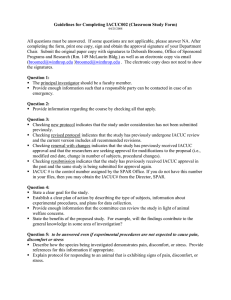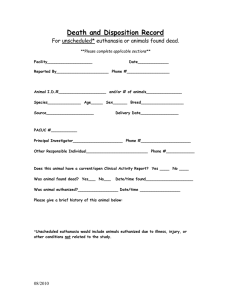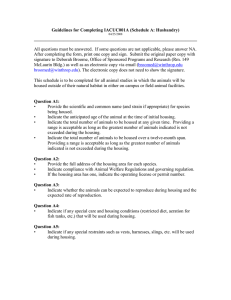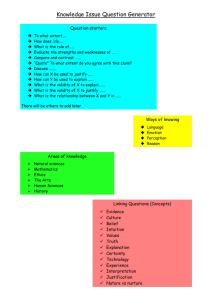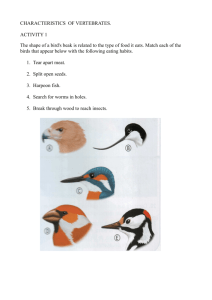Guidelines for Completing IACUC002S (Student Classroom Research Project Form)
advertisement
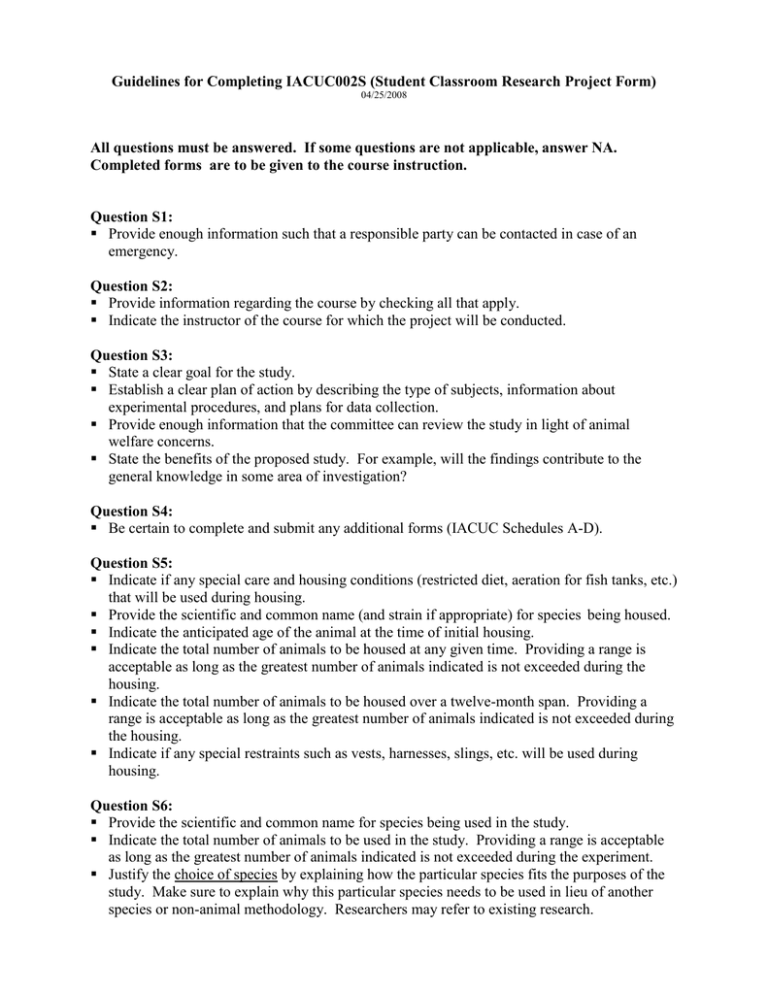
Guidelines for Completing IACUC002S (Student Classroom Research Project Form) 04/25/2008 All questions must be answered. If some questions are not applicable, answer NA. Completed forms are to be given to the course instruction. Question S1: Provide enough information such that a responsible party can be contacted in case of an emergency. Question S2: Provide information regarding the course by checking all that apply. Indicate the instructor of the course for which the project will be conducted. Question S3: State a clear goal for the study. Establish a clear plan of action by describing the type of subjects, information about experimental procedures, and plans for data collection. Provide enough information that the committee can review the study in light of animal welfare concerns. State the benefits of the proposed study. For example, will the findings contribute to the general knowledge in some area of investigation? Question S4: Be certain to complete and submit any additional forms (IACUC Schedules A-D). Question S5: Indicate if any special care and housing conditions (restricted diet, aeration for fish tanks, etc.) that will be used during housing. Provide the scientific and common name (and strain if appropriate) for species being housed. Indicate the anticipated age of the animal at the time of initial housing. Indicate the total number of animals to be housed at any given time. Providing a range is acceptable as long as the greatest number of animals indicated is not exceeded during the housing. Indicate the total number of animals to be housed over a twelve-month span. Providing a range is acceptable as long as the greatest number of animals indicated is not exceeded during the housing. Indicate if any special restraints such as vests, harnesses, slings, etc. will be used during housing. Question S6: Provide the scientific and common name for species being used in the study. Indicate the total number of animals to be used in the study. Providing a range is acceptable as long as the greatest number of animals indicated is not exceeded during the experiment. Justify the choice of species by explaining how the particular species fits the purposes of the study. Make sure to explain why this particular species needs to be used in lieu of another species or non-animal methodology. Researchers may refer to existing research. Justify the use of animals. Is the use of animals logical given the purposes of the study? In other words, could the same information be gathered in another way? Justify the number of subjects. Is the number logical given the purposes of the study? If a range was given for the number of subjects, explain why the specific number could not be provided. Question S7: Provide any information about health risks, other than ordinary risk, associated with the species in this experiment. Describe precautions that will be in place to ensure the safety of the handlers and the animals. If health risks exist, explain how animal handlers will be informed of these risks. Describe procedures that will be in place in case of a health risk incident. Question S8: Provide information about the vendor or source of the animals, including location. Provide the name of the person(s) who will collect, pick up, or receive the animals. Describe the procedures for collecting, picking up, or receiving the animals. If animals are to be shipped, explain how the shipment will be received. If animals are to be transported, how will this be accomplished in a safe and humane manner? If there are any risks involved in transportation (i.e., injury or escape), explain how those risks will be minimized. Describe any procedures that will be in place to minimize stress or pain to the animals. Question S9: to be answered even if experimental procedures are not expected to cause pain, discomfort or stress Describe how the species being investigated demonstrates pain, discomfort, or stress. Provide references for this information if appropriate. Explain protocol for responding to an animal that is exhibiting signs of pain, discomfort, or stress. Describe any measures taken to maximize the health and well being of the animal over the course of the experiment. For example, describe any special handling techniques that will be employed. Question S10: Describe any situation in which animals will be euthanized prior to the end of the experiment. For example, will sick or injured animals be euthanized? Describe procedures for euthanizing animals prior to the end of the experiment. Question S11: Describe how animals will be disposed of at the end of the experiment. Verify that the plans meet federal guidelines for the disposal of the species. Note: Typical means of euthanasia for vertebrates include cervical dislocation, decapitation, gas, or lethal injection. For all methods of disposal, explain steps taken to minimize pain and stress of the animals. If euthanasia will be used, describe the exact procedures. Note: The contact information for personnel authorized to sacrifice animals should be provided. If animals will be released, describe the location and process for release. Provide evidence that the species and location are appropriate for release. For any other methods of disposal, provide rationale and procedures. Question S12: Federal guidelines strongly discourage the use of vertebrates unless absolutely necessary. Please provide ample justification for the use of vertebrates in this study.
